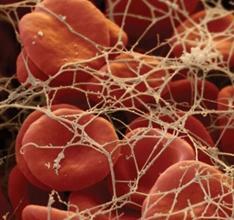Genyantritis is an inflammatory disease of the maxillary (maxillary) sinus of an allergic or infectious nature (viruses, bacteria). It is common in both adults and children. What is sinusitis in children, its symptoms and treatment will be considered in more detail.
- Does it happen that the genyantritis in children
- Causes
- How is it manifested sinusitis in a child
- Diagnostics
- What is dangerous and complications
- How to treat sinusitis in a child
- Folk remedies
- Prevention
Symptoms of sinusitis in adults - treatment of disease The most effective antibiotics for sinusitis Sinusitis: effective drops in the nose Symptoms and treatment of chronic sinusitis in adults How to make a puncture with genyantritis - the consequences
Does it happen that the genyantritis in children
The disease affects 6-9% of the child population. Often combined with respiratory viral infections, can occur under their mask. There are anatomical features of the structure of the maxillary sinus, which in the process of growing up change. At children of 1 year the maxillary sinus is not generated, therefore at the one-year-old child of a genyantritis does not happen. Gradually, the sinus is formed and turns into a full cavity.
Diseases subject to children aged 3 years. The sinus is almost formed in 12 years, lined with a mucosa, which reacts more strongly to pathological factors (infection, allergy, temperature change and qualitative composition of the inhaled air) by the appearance of inflammation with pronounced edema (catarrhal sinusitis). The older the child, the higher the risk of the appearance of pathology. The peak incidence is usually in children 5 years old.
Causes
The sinuses of the skull should be well ventilated. If there is a block of air flow, then they develop inflammation. Closure of the outlet duct of the sinus by edematous mucosa or secretion leads to the multiplication of microorganisms with the formation of purulent inflammation.
The main causes of sinusitis in children are:
- Acute respiratory diseases. The outflow of discharge from the nose is broken and on the ascending path the infection can get into the sinus. It is very harmful to sneeze "inside". This increases the pressure in the nasal cavity, the movement of the secret is sent to the side of the sinus. To prevent this from happening, you need to clear the nasal passages in time.
- Allergic rhinitis. Upon contact with the irritating substance (dust, pollen of plants, animal hair, sharp odor), a local inflammatory reaction arises that is accompanied by a strong edema of the upper respiratory tract. In the process involved and maxillary sinus.
- Trauma to the nose, which can provoke sinusitis.
- Bacterial infection on the background of weakened immunity.
- Odontogenic sinusitis. The source is dental inflammatory diseases (caries, stomatitis, periodontitis and others).
- Adenoiditis is an inflammation of the pharyngeal tonsils, which complicates nasal breathing.
- Curvature of the nasal septum, its underdevelopment. There is an uneven distribution of the air flow.
- Polyps in the nasopharynx. They can disrupt the ventilation in the sinuses, prevent the outflow of secret from them.
How is it manifested sinusitis in a child
Dr. Komarovsky singled out the main symptoms of the disease:
- Coryza. Usually, a purulent secret with an unpleasant odor is secreted.
- Capriciousness, anxiety, bad sleep.
- Raise body temperature to 39.
- Decreased appetite, until the refusal to eat.
- Pain in the area of the cheeks (in the projection of the sinus), which increases when tilted forward. Children often take a horizontal position to ease their condition.
Additional symptoms:
- Headache. More often localized in the forehead and temples. Usually occurs in children 9-10 years.
- Toothache, which is worse when chewing food.
- Redness and swelling of soft tissues over the area of the affected sinus.
- Decreased sense of smell. The mucous membrane is swollen, the sensitivity of the receptors to smells is reduced.
- Edema of the periorbital region. The upper wall of the sinus is the eye socket. Inflammatory process can pass to it.
- Change of voice. The sinuses perform a resonating function. It becomes a nasal speech.
- Cough with genyantritis occurs due to irritation of cough receptors draining along the back wall of the pharynx with nasal mucus.
With the flow out:
- Acute sinusitis - clinical symptoms are bright, painful syndrome is very pronounced.
- Chronic sinusitis - periods of exacerbations alternate with remissions. The mucous membrane undergoes irreversible changes, loses its protective properties.
Important! Regardless of the manifestations of sinusitis, a child in this state needs a thorough diagnosis and competent treatment!
Diagnostics
It is based on data from complaints made by the parent or the child himself. Children older than 5-7 years can actively complain of malaise. The next step is to examine, evaluate clinical symptoms.
The diagnosis is confirmed by laboratory-instrumental methods of research:
- General blood analysis. There is an increase in the level of leukocytes, ESR, a shift of the formula to the left.
- Radiography of the skull in a direct projection. The picture shows a darkening in the sinuses.
- Diaphanoscopy of the nose - translucence of the sinuses with the help of a special light bulb. In the normal state, they transmit more light than with inflammation. It is given to children who are contraindicated in radiology.
- Computed tomography is a highly accurate method of diagnosing sinusitis of children, but not always accessible to a medical institution.
- Puncture of the sinus with subsequent sowing of the contents on the microflora and sensitivity to antibiotics.
What is dangerous and complications
A purulent focus will always find a way out if it is not removed. Pus can dissolve any tissue of the body, including bone. Gaimorov's sinus adjoins the oral cavity, with the eye socket, and the exudate can find a way out in them.
The consequences of maxillary sinitis are serious, so neglecting symptoms and delaying the process of treatment for parents is not worth it. The disease can cause such complications:
- orbital diseases;
- otitis;
- osteomyelitis of the upper jaw;
- rheumatic heart disease;
- spread of the process to other sinuses of the skull;
- intracranial complications - meningitis, brain abscess.
How to treat sinusitis in a child
There are two treatment options: conservative (taking medications and physiotherapy) and surgical (puncture of the sinus, evacuation of its contents and sanitation of the cavity). There is also a treatment at home using traditional medicine. Usually, there is no harm from such therapy.
Only complex treatment is able to interrupt the process at an early stage. What medications are needed and how much to treat sinusitis, the doctor decides.
Medication:
- Local vasoconstrictive drops in the nose - Nazivin, Naftizin, Otrivin, Sanorin. Promotes the removal of edema, improve the patency of nasal passages. Preliminary it is necessary to wash out a nose a physiological solution. Drops can not be used for more than 7 days, it can cause atrophy of the nasal mucosa.
- Antihistamines - in the allergic nature of inflammation (Zodak, Zirtek).
- Antibiotics. Are directed on destruction of an infection and removal of inflammatory process. The most commonly used effective antibiotic is Sumamed. Well proven themselves Augmentin, Amoxicillin, Azithromycin, Supraks. The drugs are applied for 10-14 days.
- Combined Polidex preparation for topical application. Contains a glucocorticosteroid, an antibiotic and a vasoconstrictor component. Apply to children from 2 years old course 5-10 days for 1 injection into each nostril 3 times a day.
- Means that dilute the secret of the respiratory tract. Sinupret - a preparation of plant origin, contributing to better mucus discharge. Apply at the age of 2 to 6 years, 15 drops 3 times a day for 14 days.
- Antipyretics - Efferalgan, Ibuprofen, Nurofen.
How long does it take to treat sinusitis? It all depends on the severity of the disease and the presence of complications. The decision is made by the attending physician. It is important to follow the scheme of prescribed therapy and be sure to complete the course of taking medications. The error of some parents is the cessation of treatment when the child's condition improves.
Folk remedies
These drugs can not be the main method of treatment. But they are suitable as an additional method. Consider the most common recipes.
Sage and chamomile
It should take 1 hour. l. dried sage and chamomile, add 0.5 liters of water. Put on a small fire cook for 15 minutes. Cool slightly, pour into the inhaler. Let the child breathe as long as there is steam. This method is not suitable for purulent sinusitis.
Pine and cedar oil
It will take a few drops of these essential oils. Apply the mixture to the nose and nose. Massage with light massage movements. Manipulation in this case should not cause discomfort in the child.
Honey and Aloe
Ingredients take in the same proportions, mix thoroughly. Drip the mixture into each nostril 3 drops 3 times a day.
Propolis and butter
It will take 1 hour to prepare this medication. l. tinctures of propolis and 1 tbsp. l. softened butter. Mix the ingredients thoroughly. Prepared with ointment soak turundas, put into the baby's nose for 10 minutes. The procedure should be repeated 2 times a day.
Before using alternative medicine, consult your doctor.
Prevention
To prevent the development of sinusitis in a child, you must adhere to the following rules:
- observance of personal hygiene;
- timely detection and treatment of colds;
- elimination of anatomical defects in the structure of the nose, pathological growths;
- hardening, walking in the fresh air;
- physiotherapy;
- correct mode of work and rest;
- full nutrition, enriched with vitamins and trace elements.
Sinusitis is a serious threat to the health of the child. Only conscientious attitude of parents, proper care of children will help in time to cope with the disease and avoid serious complications.



